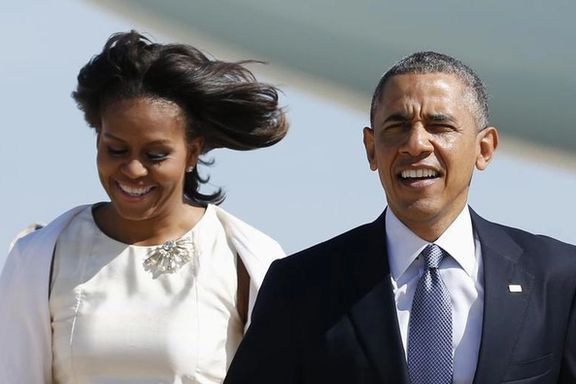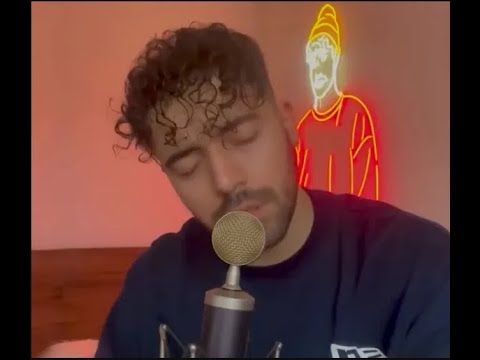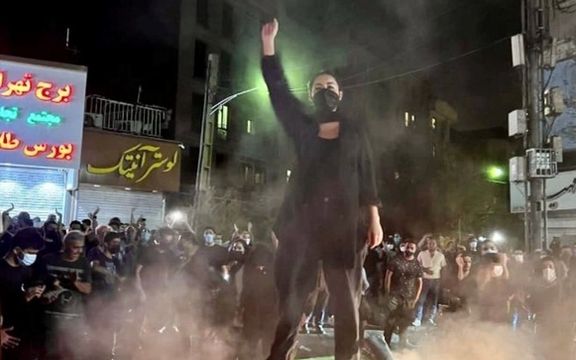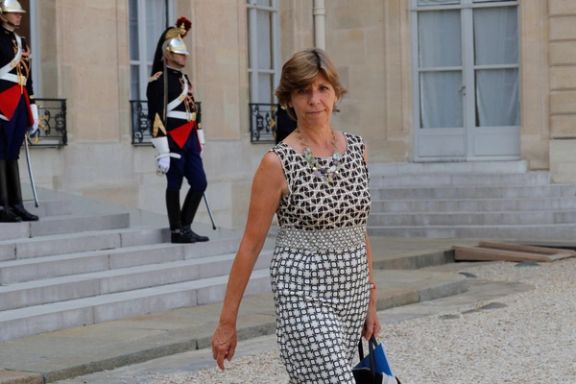To Belittle Protests, Khamenei Calls Iran’s Uprising ‘Scattered Riots’

While protests are raging across Iran Wednesday, Islamic Republic’s ruler Ali Khamenei called the uprising "scattered riots" designed “by the enemy.”

While protests are raging across Iran Wednesday, Islamic Republic’s ruler Ali Khamenei called the uprising "scattered riots" designed “by the enemy.”
Khamenei, who had already tried to downplay the antigovernment protests last week, made the remarks on Wednesday as protests began in major cities across the country amid a near total internet shutdown and choppers hovering above Tehran. Earlier in the month, he claimed protests were planned by the US and Israel and not staged by "ordinary Iranians."
"These scattered riots are the passive and clumsy design of the enemy against the great and innovative developments and movements of the Iranian nation," the Supreme Leader said.
Without providing any explanation, he said, “The Iranian nation made great moves in a short period of time, which were 180 degrees opposite to the global arrogance’s policies, and they were forced to react,” referring to the United States and other Western powers.
Describing the protests, that are garnering more support from the international community, as a “minor incident,” he said, “The constructions, great executive works, effective legislation, big judicial works, and important issues in foreign policy should not be sidelined by these minor incidents.”
Tehran Youth, presumed to be a group of young activists who have taken the lead in current protests issued the call for Wednesday’s nationwide protests after security forces used military weapons against protesters in the Kurdish city of Sanandaj earlier this week.
Protests over the death of Mahsa Amini, a 22-year-old Kurdish Iranian woman who died in the custody of the hijab police, started in her hometown Saqqez and capital but soon spread all over Iran.

Former US President Barack Obama and first lady Michelle have expressed solidarity with Iranian women and girls who have “inspired the world” through their protests.
The Obamas issued a statement Tuesday on the occasion of International Day of the Girl, saying they are "in awe" of those who have joined the reignited fight for women's rights in Iran.
Condemning the clampdown on popular uprising sparked by the death in custody of 22-year-old Mahsa Amini, they said, "The rights they seek are universal: equality, the ability to make their own choices about how they look and dress and express their identities, and the freedom to do so without facing harassment, intimidation, and violence.”
Addressing protestors, the Obamas said, "We are moved by your acts of protest, and bear witness to your bravery in facing down the brutality of a regime resisting calls for change. You are delivering a powerful message that injustice should not be tolerated."
They sympathized with those who have tragically lost loved ones and expressed hope that “the future will ultimately belong to the young women and girls of Iran who are refusing to be silent.”
“You remind us that true power comes not from clinging to the past, but from the effort to build a better future," they said.
Earlier in the month, President Joe Biden said, “The United States stands with Iranian women and all the citizens of Iran who are inspiring the world with their bravery."
Amid a near total internet shutdown across Iran and government helicopters circling above Tehran on Wednesday, protests are going on.

Iranian protest song by singer-songwriter Shervin Hajipour, which has become the anthem of the current uprising, has flooded the submission box for the Grammys’ newest special award category.
The song “Baraye...” -- which means “For the Sake Of” in Persian -- received 95,000, or over 83 percent, of the 115,000 total submissions for the award following a campaign on TikTok urged users to nominate the song, which is the de-facto manifesto of the protests.
It has been reuploaded to YouTube and other social media platforms, and “was used by Iranians all over the world as a rallying cry,” a crowdsourced guide for nominating the song for a Grammy says.
The special merit award is meant to honor a song “that has had a profound social influence and impact,” the Recording Academy said on its website. Submissions are open through October 14.
The Recording Academy was “deeply moved” by the social media campaign, Chief Executive Officer Harvey Mason, Jr. said in an e-mailed statement. “While we cannot predict who might win the award, we are humbled by the knowledge that the Academy is a platform for people who want to show support for the idea that music is a powerful catalyst for change.”
Hajipour, who shared his song amid the protests over Mahsa Amini’s death in custody of hijab police, was himself arrested and released on bail and later was banned from leaving Iran on charges of anti-regime propaganda and inciting violence. He composed the song from tweets and other social-media posts from protestors commemorating Mahsa Amini.

Iran’s interior minister Ahmad Vahidi Tuesday claimed that overthrowing the Islamic Republic “is a stupid idea” because the regime is at “apex of its power”.
The minister was visiting the western city of Sanandaj where protesters have been defying hundreds of government troops and gunmen for at least three days. There are no clear figures about casualties in the city but several people have been killed and dozens injured by live fire.
Reports by activists on social media indicated that the wounded have been turned away form hospitals, or they have refused to seek help knowing that doctors are under orders to call security agents when a wounded person is brought in. The government arrests them on the spot before they are treated and taken to prison.
Demonstrators were chanting and bullets flying in Sanandaj as the interior minister was apparently inspecting a water project in the area. The city has a majority Kurdish population and was one of the first spots where protests started in mid-September, following the killing of Mahsa Amini in the custody of Iran’s notorious hijab police.
There were also bloody protests in other Kurdish-populated cities and towns such as Baneh and Saqqez, the hometown of Mahsa Amini. These protests were continuing Tuesday night at the time of this writing.
Strikes by oil and petrochemical workers that started Monday continued in some spots on Tuesday, notably at the oldest refinery in the Middle East in Abadan, near the Persian Gulf. There were also strikes in Asalouyeh, a city which is home to many petrochemical and natural gas plants.
A video released by striking workers threatened destruction of plants and equipment if the Revolutionary Guard and its various armed groups do not lay down their weapons and stop killing civilians in the country.
Wednesday can become another milestone in the 26-day old antigovernment protest movement that clearly has assumed features of a revolutionary push to overthrow the clerical regime in Iran. A group of activists known as ‘Tehran Youth’ have called for nationwide protests on Wednesday. This was the group that had called for the large protests on Saturday, October 8, which brought out crowds in various parts of Tehran and several other cities, showing the power of the “revolutionaries”.
The call for another round of nationwide protests starting at noon October 12 came as a response to government violence in Sanandaj, amid a mood of national unity against the Islamic Republic. Protesters proudly highlight slogans of mutual support, especially for outlying regions such as Kurdish areas close to Iraq and the Baluch city of Zahedan which is located at the opposite end of the vast country, near Pakistan.
The Baluch region is a neglected and poor part of Iran, where security forces more likely felt they could kill more indiscriminately on September 30 when around 60 protesters were gunned down in Zahedan. The death toll has now risen to around 90.
No one knows exactly how many people have been killed nationwide, but some human rights groups put the figure at close to 200. Security forces have also arrested between four to five thousand protesters, including many university students and even school children.

French Foreign Minister Catherine Colonna said Tuesday Paris was pressing Iran to free detained nationals, confirming five were currently held.
“I hope to speak to the Iranian foreign minister today to ask once again for the immediate release of all our compatriots,” Colonna told France Inter radio. The minister said she expected a meeting of European Union foreign ministers October 17 to “validate” a set of sanctions against Iran targeting those “behind the repression.”
France Monday advised nationals against going to Iran for any reason and directed those there “to limit their movements…to imperatively avoid any type of gathering and to make themselves known to the French Embassy in Tehran.”
The five French detainees include Cecile Kohler, a trade union leader, and her partner Jacques Paris, who were arrested in May, accused of involvement in teachers’ protests seeking higher pay, and whose ‘confessions’ aired last week on an Iranian state television station. The pair said they were in Iran on holiday. A trailer on the Arabic-language Al-Alam station said they had arrived with “packets of money.”
Also in jail is French-Iranian researcher Fariba Adelkhah, arrested 2019 and sentenced to five years in prison for “undermining national security.” Another French citizen, Benjamin Briere, was arrested in May 2020 and sentenced to eight years and eight months for espionage, without due process of law.
‘Adhere to the rules’
After the recent outbreak of protests following the September 16 death of Mahsa Amini after her arrest in Tehran by ‘morality police,’ Iran said late September it had detained nine foreign nationals linked to unrest, including those from France, Germany, Italy, Poland and the Netherlands.
Foreign Ministry spokesman Nasser Kanaani said Monday that foreigners “should adhere to the rules and regulations and not enter into issues that are basically not within the scope of the normal travel of foreign citizens.”
The French embassy in Tehran Tuesday announced delays in processing visa applications from Iranians due to “the internet filtering the Iranian authorities have decided to do.” Harmatullah Rafiei, head of a leading tourism association, had earlier suggested some European embassies had suspended processing Schengen visas. Iran argues that social media has been used by foreign-based groups to foment violence including attacks on ambulances.

‘Brutal suppression’
The European Union has as yet given no indication of what sanctions may be agreed at the foreign ministers’ meeting October 17. German Foreign Minister Annalena Baerbock told Bild am Sonntag, a Sunday newspaper, that Berlin would support measures freezing the assets and banning the EU entry of those responsible for “brutal suppression,” referring to antigovernment protests.
While Baerbock did not name any persons or organizations, the United Kingdom announced Monday it was sanctioning Iran’s ‘morality police,’ the police’s national head Mohammad Rostami and its Tehran chief Ahmad Mirzaei, and well as national police chief Hossein Ashtari and other officials, whom it accused of “serious human rights violations.” Tehran summoned the British ambassador Monday evening to protest over ‘interference in internal affairs.’

Many people injured by the Islamic Republic’s security forces amid current protests avoid treatment in hospitals for fear of being arrested, reports say.
According to a Tuesday report on CBS News, the wounded protesters attempt to treat themselves at home, "somehow," as security forces scan hospitals to detain injured people.
Some Iranian medical professionals, who spoke to CBS on condition of anonymity out of concern for their safety, said they felt a duty to help the wounded, with one of them – who is a nurse – saying that she treated two protesters whose skulls had been fractured. "They were afraid to go to the hospital," she said, adding that she had to tend to their wounds on the street during the unrest.
Another Iranian nurse and emergency call operator said, "We are required to report all gunshot cases to the police because all of the phone calls are recorded,” noting that the risk of arrest to injured protesters is real.
Dr. Kayvan Mirhadi, an Iranian American and chief of internal medicine at the Clifton Springs Hospital in New York, said he receives around 500 Instagram messages daily from wounded protesters from Iran, begging him for medical advice.
He said if he fails to refer them to his trusted doctors in Iran, he tries to walk them through the best home remedies possible. According to him, their injuries range from fractures and significant head injuries, to second- and third-degree burns from electric batons, as well as bullet and pellet wounds.
According to another doctor, ambulances in the capital Tehran transport injured protesters directly to police stations. "As soon as they enter the hospital, there are intelligence agents and members of Revolutionary Guards who record their names," he said.